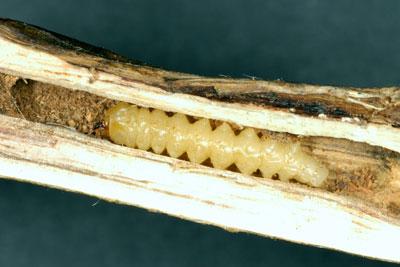Survey of Orange Gall Midge in Nebraska: A Potential Pest of Soybeans
August 23, 2018
A relatively new insect in soybean, the orange gall midge has now been confirmed in 15 eastern Nebraska counties.Growers and consultants are invited to submit reports of orange gall midge in counties where it hasn't previously been identified.
Scouting for Soybean Stem Borer Damage
August 9, 2018
High populations of soybean stem borers may predispose your field to lodging and complicate harvest. Fields with higher levels of injury should be harvested first to minimize lodging losses.
Soybean Defoliators
August 1, 2018
Defoliation injury is being reported in soybeans and often can look worse than it is. This illustrated guide to assessing injury can help you get reliable scouting numbers on which to base sound treatment decisions.
Orange Gall Midge in Soybeans
August 1, 2018
Reports of orange gall midge in soybean increased in Nebraska this year and researchers have initiated in-field and laboratory studies to help learn more about its potential to reduce yield as well as best practices for its management.
Japanese Beetle in Corn and Soybeans
January 8, 2018
An article from the 2018 Crop Production Clinic Proceedings on distribution, scouting and damage from Japanese beetles in Nebraska corn and soybean.
Scouting and Treating Western Bean Cutworm
July 11, 2018
Western bean cutworm egg masses have been reported on field corn in a number of locations across the state this week. Here's what to look for in the field, treatment thresholds and recommendations.
Insects in Cover Crops
January 8, 2018
An article from the Proceedings of the 2018 Nebraska Extension Crop Production Clinics on how integration of cover crops in cropping systems will alter pest and beneficial insect activity.
Western Corn Rootworm Beetles Emerging, Time to Scout
June 27, 2018
Corn rootworm beetles started emerging in southeast and south central Nebraska and scouting is recommended. An average of 5-10 beetles per ear usually can seriously affect pollination.








